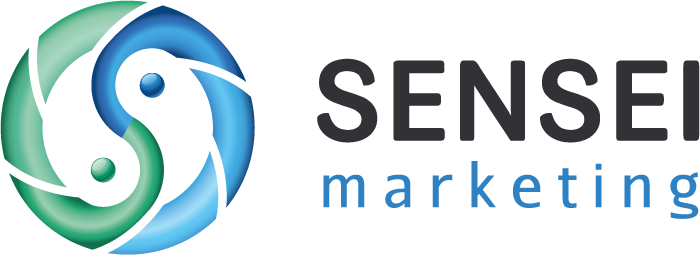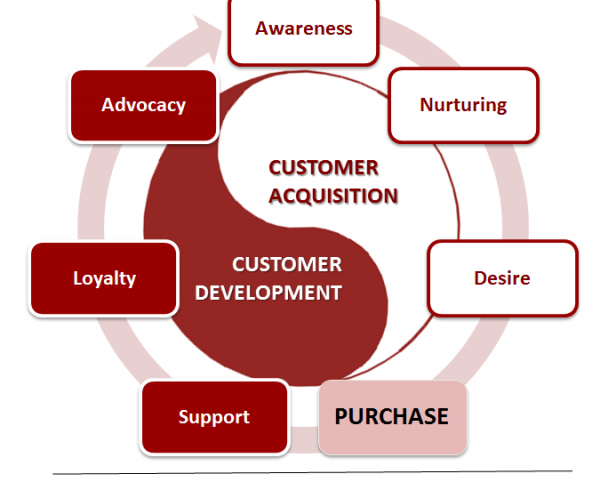Advocacy, the third stage in the Customer Development sphere of the Sensei Customer Lifecycle model, is the culmination of the business’ effort to engage and support the customer. A customer who has reached this stage in the lifecycle has experienced the seamless conversion of your relationship from vendor-prospect to vendor-customer and now embraces you as a business “partner” more than a vendor.
See posts on the first two stages of the Customer Development cycle:
A Purchase Order Does Not Guarantee Customer Loyalty
Advocacy, Not Sales, is the End Goal of B2B Loyalty
At this point, your team and processes have become integrated with those of your customer. You’ve established real-time pathways for communication and you’re providing relevant marketing, sales and business development support. Your customers are satisfied and you’ve earned their loyalty; you’ve created an advocate. Your job is done; sit back and watch the leads come flying in.
Not so fast. Marketers have grossly over-estimated advocacy. Referrals – even among those customers from whom you’ve earned loyalty – aren’t assured. Further, they’re not guaranteed to be quality leads nor qualified leads. This is not the time to become lax in your engagement efforts.
Advocates and the referral process still require proactive management to successfully feed the “Awareness” stage in the Customer Acquisition sphere of the lifecycle. Below are some recommendations:
1. Set Advocate Expectations
If performance expectations were not conveyed to a newly-hired salesperson within your firm, what do you believe their success would be? The same applies to customer advocates. While the best referrals often come from genuine customer commentary, it’s human nature to complain about the products and services we dislike more than complimenting those that we appreciate.
For this reason, a business should not shy away from asking for referrals from potential advocates. Since these customers now consider you a business partner rather than a vendor, such requests are usually accepted and acted upon gladly.
Note: requests for referrals are less effective and generate fewer qualified leads when made to customers who have not progressed to this stage of the customer lifecycle.
2. Categorize Advocates
Generic requests for referrals may encourage lead quantity but neither quality nor high conversion. The goal of advocacy is to increase qualified, measurable leads into the Customer Acquisition sales funnel.
To do so effectively, your business must first qualify the referrers based on the influence they have within their community, the quality of relationship you have with their key players, the size of their industry, etc., as applicable to your business and industry.
Values are placed on each “advocate category” based on share of wallet earned, profit generated, ease of doing business, speed the customer progressed along the lifecycle, etc.
Leads are tracked back to the customer advocates and their categories, providing context, prioritization and instruction for the sales team to better manage the lead funnel.
3. Enable Advocates
Requests for leads, regardless of how willing the customer advocate is, do not always generate action. Translating the willingness to refer into taking action requires you to empower the advocate with the right content and means to act upon that desire.
Online tools such as referral forms, co-branded blog posts, etc. or offline events where advocates are encouraged to invite colleagues to a networking event can enable customers to act on your behalf.
Without context and timing however, such tools are less effective. As with the Loyalty Phase of the Customer Lifecycle, relevance is critical to success. Blindly sending requests for referrals to advocates dilutes the referral pool and challenges their good will. Generate a plan that strategically asks for referrals from specific customers when relevant transactions occur such as customer feedback, successful resolution of a customer complaint, financial milestones, etc.
4. Acknowledge Advocates
As with other good deeds, referrals are cause for celebration and a genuine expression of appreciation. Acknowledging the value of a customer’s referral provides the positive reinforcement required to maintain the balance between the two partners in this venture: vendor and customer.
Further, it’s imperative to highlight converted leads and the impact that the new customer provides the referring customer, not your business. The value to your business is understood; you’ve increased your revenue. The value to the referrer is not so clear so it’s important to highlight the connection between their action, the converted lead and the benefit to their business.
What has this new client, the lessons learned or the additional revenue added to your business that will directly impact the referring business? Can some new partnership or benefit be created by having both clients reselling your product?
Notice that we didn’t list “reward advocates” here. Rewarding advocates with financial incentives and other perks is often appreciated but typically carries only short-term value. Improving the advocate’s business and/or the relationship between the business partners is strategically a better long-term plan.
The lesson to be learned is that advocacy is not to be taken for granted. Advocacy – and advocates – must be planned, managed and tracked as carefully as any other stage in the Customer Lifecycle. Advocacy is the launching point for new customers, not the end-point of the service team’s customer management efforts.
Join the conversation. Is this a realistic model for B2B organizations? Or are they simply too focused on short-term goals for such long-term strategic planning?
Sam Fiorella – Sensei
Feed Your Community, Not Your Ego




